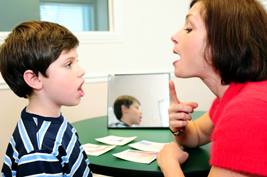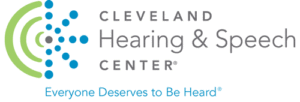What is the typical progression for learning to produce the speech sounds?
Children begin developing speech as an infant. By 6 months of age, babies coo and play with their voices producing sounds such as “oo, uh, mm, da, and goo.” Children learn speech by imitating the sounds they hear. Caregivers talking about what they are doing during the day, singing songsand reading books expose the child to a variety of sounds that he/she will begin imitating.
Your child will continue to coo and begin to babble, producing more consonants such as “b” and “k” with different vowel sounds. By 12 months of age, babbling should begin to sound like “talking” with intonations and rhythm. This is called jargon. Between 12 and 18 months of age, your child’s speech should contain a variety of sounds including: m, b, n, p, b, d, t, h, sh, w, k, g and vowels. Your child also will be producing a variety of “word shapes.” This refers to the arrangement of consonants (C) and vowels (V). Examples of these include “up” (VC), “shoe” (CV), and “hot” (CVC). As your child’s vocabulary grows, so should the ability to produce different speech sounds and combine sounds in more complex ways (for example, three-syllable words, such as “banana” and consonant clusters, such as “spoon”). Imitation of sounds and word shapes continues, maturing into natural, spontaneous productions. Your child will produce a variety of age-appropriate sounds and word shapes. Single words will be combined into two- and three-word phrases, and eventually into sentences and ongoing conversation.
What are articulation, intelligibility and phonology?
Most children make some mistakes as they learn to say new words. A speech sound disorder occurs when mistakes continue past a certain age. Different sounds are mastered at different ages. Consistent, correct sound production will vary from child to child. Speech sound disorders include problems with articulation (pronouncing sounds correctly) and phonological processes (errors with sound patterns).
Can you understand what your child is saying? Does your child speak clearly? Do you have to translate your child’s speech for others? This is called intelligibility. The term intelligibility refers to how much a listener can understand the speaker. In typical development, as your child learns to talk, his/her ability to be understood by those around them steadily increases.
Parents and close family members are usually experts at understanding their own child’s speech attempts. Parents can “translate” even the most unintelligible efforts made by their children. Unfamiliar listeners, on the other hand, are often unable to decipher a young child’s speech.
Here are some general guidelines:
Approximate age and percentage of speech understood by parents:
At 8 months, a typical child is 25 percent intelligible.
At 2 years, a typical child is 50 to 70 percent intelligible
At 3 years, a typical child is 80 percent intelligible
At 4 years, a typical child is 90 to 100 percent intelligible
What are common disorders of speech sound production?
An articulation disorder involves problems pronouncing sounds correctly. Sounds can be substituted, left off (omitted), added or changed. These errors may make it hard for people to understand your child. Young children often make speech errors. For instance, many young children sound like they are making a “w” sound for an “r” sound (e.g., “wabbit” for “rabbit”) or may leave sounds out of words, such as “poon” for “spoon.” Your child may have an articulation disorder if these errors continue past the expected age.
Not all sound substitutions and omissions are considered speech errors. Instead, they may be related to a feature of a dialect or accent. These types of differences may or may not be considered a speech disorder. An evaluation that determines the consistency of a speech sound error and the situations in which that error occurs will help determine this.
A phonological process disorder involves patterns of sound errors. For example, a child might substitute all sounds made in the back of the mouth like “k” and “g” (back sounds) for those in the front of the mouth like “t” and “d” (front sounds). This particular phonological process would be called fronting, and the child might say “tup” for “cup” or “dirl” for girl).
Another rule of speech is that some words start with two or three consonants. These are referred to as consonant clusters. Examples of consonant clusters include “street” or “broken.” When first learning to speak, your child might simplify these consonant clusters by leaving one of the sounds out. Your child might say “teet” for “street” or “boken” for “broken.” When children simplify these clusters, it is more difficult for the listener to understand the child. While it is common for young children learning speech to leave one of the sounds out of the word, it is not expected as a child gets older. If a child continues to demonstrate such cluster reduction, he or she may have a phonological processing disorder. Varieties of such phonological process rules exist, and children may exhibit some or all of them at one point or another in their acquisition of speech. There are several different phonological disorders that may occur and a careful analysis of speech sound production will help identify these.
Verbal apraxia of speech is a motor speech disorder. Children with verbal apraxia have difficulties sequencing sounds, syllables and words. This is not because of muscle weakness or paralysis. To say any sound or word, the brain sends a command to the necessary muscles to activate and produce that sound or word. With verbal apraxia of speech, there is a problem in sending this command that results in improper sequencing of the movements required to produce the sound/word. This in turn results in an sound or word error. The child knows what he or she wants to say, but communication of this idea from the brain to the various muscles of the speech mechanism is disrupted. Early warning signs of apraxia include: quiet babies, very little to no cooing or babbling, struggling with simple babbling sequences, producing only vowels or very few consonants, delayed first words (says first word after 18 months of age), difficulty imitating speech, difficulty saying longer phrases.
Verbal apraxia refers to difficulty producing sounds. Oral apraxia refers to difficulty with movements of tongue, lips or jaw when desired. For example, your child might stick out his tongue to lick an ice cream cone, but may not be able to stick the tongue out when asked. Oral motor difficulties may be present with or without verbal apraxia. Oral motor difficulties may be noticed in activities such as sucking and feeding. They may or may not contribute to speech production problems.
Stuttering is characterized by tense, rapid repetitions of words (my, my, my), or syllables (mom-mom-mom-mommy), or sounds (m-m-m-m-mine); blocks, fillers (“um”), or prolongations of a sound unintentionally (mmmmmmommy). In the course of speech-language development, a natural period of normal dysfluency commonly occurs between the ages of 2 and 4 or 5 years. This is not stuttering but may sound like it. You might be concerned when you hear this, and if so, a speech-language pathologist can evaluate your child’s speech pattern to determine if your child is going through a period of normal disfluency or if what you’re hearing may in fact be stuttering. Some warning signs that may prompt you to consult a professional to help include if your child has been stuttering for longer than 6 months, has been stuttering with considerable effort and tension or stutters while using body movements (head jerking, eye blinks, hand movements). Click here for more information about childhood stuttering.
What can I do if I cannot understand my child’s speech?
You can have your child’s speech evaluated. Ask your pediatrician for a referral to a speech-language pathologist. A speech-language pathologist (SLP) is the professional who diagnoses speech and language difficulties. An evaluation will include the following:
-
The SLP listens to and watches your child and will use a formal articulation test to record sound or phonological errors, as well as gather a speech sample to provide further clinical analysis.
An oral mechanism examination is also done to determine whether the structure and function of the mouth are adequate for speaking. This involves looking in your child’s mouth and observing the accuracy and coordination of the movements of the articulators (jaw, lips and tongue).
Assessment of a child’s language skills is also typically completed at this time through standardized testing and analysis of communication behaviors. Both receptive and expressive language are assessed to the fullest extent possible. Receptive language refers to your child’s ability to understand, follow directions, etc. Expressive language refers to your child’s ability to use language to convey wants, needs and ideas.
The results will provide an overall view of how your child is communicating, which skills are emerging, which skills have been mastered, and, possibly, areas of struggle. When the assessment reveals that your child may need therapy to improve speech sound production, the SLP may recommend speech therapy in group sessions or individual sessions. The frequency of sessions (weekly, every other week, twice a week) will depend on your child’s needs.
Speech-language pathologists provide treatment to improve articulation and phonological processing problems.
Articulation treatment will involve demonstrating how to produce the sound correctly, learning to recognize which sounds are correct and incorrect and practicing sounds in different words. Phonological process treatment will involve teaching the rules of speech to individuals to help them say words correctly and decrease use of the rule-based errors. All therapy requires a team approach with families to ensure that new sounds and patterns are carried over and generalized to all environments.
Information courtesy of Cleveland Hearing & Speech Center. CHSC is the premier provider of hearing, speech-language, and deaf services, education, and advocacy, helping people connect through communication.



